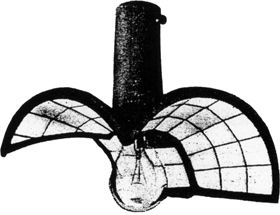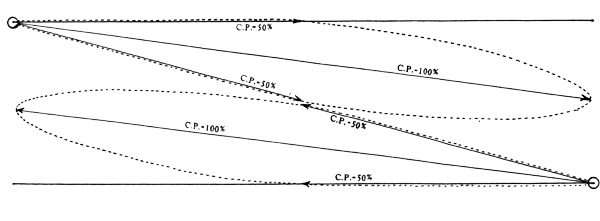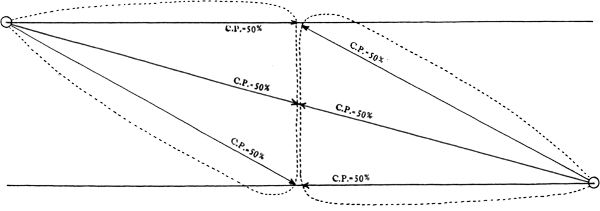 |
esla bi-multi group "a" two-way 165° 7½°
Genre: Wing type lantern
The wing type lantern was invented by Haydn Harrison in the early 1920s.
Typified by its simple construction and unique shape, Harrison's design
collected some of the flux emitted by the upper parts of a symmetrical
point light source, and fashioned it into various beams which were used
to illuminate the road surface. The flux emitted in the lower hemisphere
of the light source was uncontrolled, producing a circular pool of light
below the lantern. Therefore the lantern illuminated both the road
surface and its immediate environment.
The wings of the lantern controlled the number and angles of the beams.
Given the huge number of different lighting requirements of roads and
their environs, a large number of differently configured wing type
lanterns were produced. These differed in the number of wings and the
angles of the beam; it wasn't uncommon to find many different lanterns
lighting a single stretch of road.
The first type of wing lantern, due to Harrison, used facetted, mirrored
glass pieces stuck to a cast-iron frame (and he held the patent for the
method of arranging and sticking them). Other manufacturers also
produced wing type lanterns; but elected to use polished enamel
surfaces, curved etched and fluted glass, and/or glass strips held by
metal lugs in order to side-step the patent.
Whilst the utilization factor was lower than other lanterns (due to
little flux being collected above the lantern), and glare from the
totally exposed bulb was an issue, wing type lanterns became popular for
their sheer robustness, minimal number of parts and cheapness.
The design of the wing type lantern changed little over the next thirty
years. Although open lanterns were frowned upon by the mid-1950s
(as no protection was afforded to the bulb nor the reflective surface so
both got dirty and required regular cleaning), wing type lanterns were
still being installed in the 1960s; but in the end, discharge lamps and
the benefits of enclosed lanterns saw their eventual downfall.

Name: ESLA Bi-Multi Group "A" Two-way 165° 7½°
Date: Circa 1920s - 1950s
Dimensions: Length: 8 ½", Width: 10", Height: 9 ½"
Light Distibution: Uniform Distribution (BS 307:1927)
Lamp: 40-150W GLS
History
 The Bi-Multi, the first wing-type lantern, was invented in 1923 by Haydn
Harrison. Unable to find a manufacturer for his new lantern, he
approached schoolfriend Herbert Biggleston who owned a foundry in
Canterbury. Electrical Street Lighting Apparatus (ESLA) was founded
shortly afterwards.
The Bi-Multi, the first wing-type lantern, was invented in 1923 by Haydn
Harrison. Unable to find a manufacturer for his new lantern, he
approached schoolfriend Herbert Biggleston who owned a foundry in
Canterbury. Electrical Street Lighting Apparatus (ESLA) was founded
shortly afterwards.
The Bi-Multi was a revolution. All the other manufacturers were making
over complex, multiple part frame-type lanterns, modifications of early
gas style fittings. Harrison's genius was to simply remove all the
complexity and reduce a lantern to a bulb, focusing mechanism and simple
reflective optical system.
As epitomized by the wing type lanterns, the original Bi-Multi was made
in many variants, each characterized by different number of wings and
different beam angles. This allowed lighting engineers to select
lanterns for specific sections of road, especially for bends, dead-ends
and road junctions.
In this era before any standardization and/or conformity of mounting
heights and spacing, the original Bi-Multi was a small lantern, designed
to cast a narrow, intense beam as directed by each wing. This allowed
roads to be lit under varying conditions with a minimal number of
lanterns; but the intensity ratio was excessively high and glare was a
constant problem.

The first British Standard (BS 307:1927) did nothing to improve matters;
but the coming of the MOT Report (1937) finally standardized mounting
heights and spacing, and Harrison was able to change the optical system
of the Bi-Multi to reduce the intensity ratio and create a wider beam.
The result was the larger Bi-Multi Group "AL" (with the original
Bi-Multi system becoming the Group "A").

As bulb wattages increased, a Group "B" lantern was introduced to
light Group "A" roads (suggesting that Harrison's lantern predated the
standard naming of the MOT Report). Twin lamp version also appeared, but
were only used for special circumstances.
Popularity
Being rugged, simple and cheap, the Bi-Multi system was extremely
popular, and these characteristic facetted lanterns could be found all
over the country. They were especially popular both with the suburban
expansions of the cities being built in the 1930s, and various Parish
Councils who needed a cheap, effective, and above all, simple lantern.
Their popularity waned in the 1950s with the coming of discharge lamps
and enclosed lanterns, and the energy crisis of the 1970s saw large
numbers being removed. Whilst only a handful on exist on the public
highway, they have become highly sought after by enthusiasts, and the
Bi-Multi has become a collector's item.
Identification
The ESLA Bi-Multi is easily identified by its glass facets. If a lantern
has three rows of mirrored glass facets then it's an ESLA. Further
identification is provided by the makers name, angular schedule, and
patent numbers on the canopy of the lantern. In early lanterns, this is
scribed into the wings (requiring paint removal to see them); on later
lanterns, these are cast as raised letters (rare) or raised letters on
blocks.
Optical System
The optical system of the ESLA Bi-Multi was based on a series of
intersecting parabolas with the bulb at the focal centre. The top half of
the parabola was fashioned into a reflective surface using facetted mirrors.
The flux collected by the mirrors was then fashioned into a beam, the
elevation, angle and number of beams corresponding to the geometry of
each wing.
Early Group "A" lanterns varied the peak angle (with the angle scribed
on the lantern's canopy) whilst Group "AL" lanterns fixed the peak angle
at 80°.
Flux emitted from the lower hemisphere of the bulb was uncontrolled, and
formed a circular pool of light beneath the lantern. Therefore, the area
around the base of the lantern was well illuminated for the pedestrian
and
house owner (e.g. pavement, front gardens and parked cars) and the road
surface was illuminated at longer distances from the lantern for the car
driver (e.g. bright road surface, dark kerb edges etc.).
Focusing was variable: the bulb assembly could be adjusted in a vertical
axis by moving the tubular bulb holder within the lantern's canopy; a
simple locking screw held it in place. The bulb's filament was
positioned at the lowest point of the wings for correct focusing, a
relatively easy task.
the esla bi-multi group "a" two-way 165° 7½° in my collection

|
|
facing profile
This lantern (and associated bracket) were discovered in a reclaim yard in North London.
The lantern itself was in good condition and it was the first of the smaller Group "A"
Bi-Multis I'd found.
|
|

|
|
front profile
The glass was in good condition and the lampholder was complete. Apart from stripping all the
paint off and repainting it, the lantern didn't require much other attention.
|
|

|
|
trailing profile
The lantern was originally painted white and I believe it originated from the London Borough of
Merton. Therefore I've kept its colour scheme.
|
|

|
|
canopy
During repainting, the etched letters identifying the lantern's angular schedule were revealed. These read:
165o 7½°
No 736776 ESLA
British Pat No 228294/23 Road -->
The second figure is believed to be the peak angle below the horizontal which was variable for these Group "A" lanterns. (In the
later Group "AL" lantern, it was fixed to 10°).
|
|

|
|
pedestrian view
The lantern has been fitted with a Derby 100 bulb, the original specification for this lantern (which shows how small this lantern is when
compared to its larger Group "AL" siblings).
|
|

|
|
vertical
The lantern has the familar ESLA configuration of three rows with ten columns.
None of the centre glass has survived.
It was retained on its original Lucy bracket.
|
the esla bi-multi group "a" two-way 165° 7½° during restoration
This shot shows the finished lantern on the half-restored bracket. It was taken just after fellow collector Phil found a
replacement cover for the time switch and fuse box.

|



